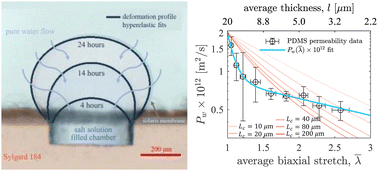Deformation-dependent polydimethylsiloxane permeability measured using osmotic microactuators†
Abstract
In soft solids, large deformations significantly alter molecular structure and device geometry, which can impact other properties. In the case of mass transport, an interplay between flux and mechanical deformation results. Here we demonstrate a platform for the simultaneous characterization of mechano-permselectivity using the (slow) transport of water through polydimethylsiloxane (PDMS) as a challenging test case. The platform uses micron-sized, cylindrical, NaCl solution-filled PDMS chambers encapsulated by selectively-permeable PDMS thin film membranes. When placed in a high chemical potential environment (high water potential) the osmotic pressure difference between the chamber and environment induces water to flow through the PDMS membrane into the chamber, resulting in membrane bulging. A model combining membrane flux and nonlinear elasticity captures the time-dependent response well, but only when a deformation-dependent permeability is used. Notably, the permeability of water through PDMS decreases by nearly an order of magnitude, from 2 × 10−12 to 5 × 10−13 m2 s−1, due primarily to its thickness decreasing by nearly an order of magnitude as the average biaxial stretch increases from 1 to 2.75.



 Please wait while we load your content...
Please wait while we load your content...